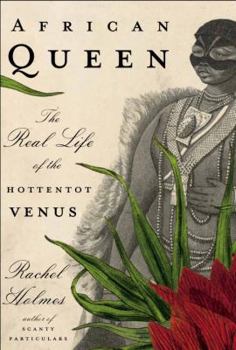African Queen: The Real Life of the Hottentot Venus
Select Format
Select Condition 
Book Overview
Saartjie Baartman was twenty-one years old when she was taken from her native South Africa and shipped to London. Within weeks, the striking African beauty was the talk of the social season of... This description may be from another edition of this product.
Format:Hardcover
Language:English
ISBN:1400061369
ISBN13:9781400061365
Release Date:January 2007
Publisher:Random House (NY)
Length:161 Pages
Weight:0.90 lbs.
Dimensions:0.9" x 5.9" x 8.5"
Customer Reviews
5 ratings
African Queen: The Real Life of the Hottentot Venus
Published by Thriftbooks.com User , 14 years ago
Read an article in the Washington Post about this book so I decided to order it. I was not disappointed. Very interesting read.
Well done story of racist and sexist exploitation
Published by Thriftbooks.com User , 17 years ago
The subject matter (the sad tale of Saartjie Baartman, a well-endowed African woman put on British and French freakshows as the "Venus Hottenot" whose gelueteus is exploited to the maximus) has been discussed by the other reviwers. Therefore, I would like to commend the author for her excellent use of primary sources in the telling of this story. We see shockingly crude cartoons mocking Saartjie's buttocks (often comparing her with Lord Glenville, a forgotten british statesman with a comparatively large derriere) and giving her a ridiculous pidgin English that she obviously didn't speak. We read from the handful of known interviews with her as welll as trial transcripts (as her exploiters are taken to court). This combined with Nelson Mandela's recent efforts to get her reburied with dignity in her native South Africa all make for a compelling story and good written history. This book should be required reading for the modern rumpmistresses who thoughtlessly shake their gleuteus to the maximus on the likes of BET and MTV.
Very interesting.
Published by Thriftbooks.com User , 17 years ago
Gives yet another look into the dark chapters of the African Human Experience.
Well written book on a very interesting topic
Published by Thriftbooks.com User , 17 years ago
The casual reader might be put off by the slow start -- the author has to establish the historical base and lay out many details, BUT once into the story it quickly gets to the heart of the matter, exploitation, de facto or otherwise, of a black African female. Not a pretty topic, but when it's handled as it is here by a sympathetic writer it becomes a fascinating story and a memorial to the heroine, Saartjie Baartman.
from [...].
Published by Thriftbooks.com User , 17 years ago
The Hottentot Venus exhibit--promising to present a rare African woman from the Hottentot region for public view--opened in London in 1810 to an expectant audience waiting to see the new curiosity otherwise known as Saartjie ("Saar-key") Baartman. Saartjie's skills as a performer combined with her particularly large buttocks and allusions to her supposedly extended labia only added to the exhibit's appeal to rich (white) Londoners. According to Rachel Holmes, author of "African Queen: The Real Life of the Hottentot Venus," Saartjie Baartman is one of South Africa's most widely known historical figures. Everyone in South Africa knows Saartjie's name and story. Born in 1789, Saartjie was illegally transported to England by her master Hendrik Cesars, a free black, and Cesar's employer military doctor Alexander Dunlop. Once in London, Saartjie debuted as the Hottentot Venus. Singing and dancing and generally exhibiting herself in "tribal" attire before fashionable Londoners in the audience, Saartjie was, Holmes writes, "got up like a fetish and a showgirl." It also helped that Lord Granville, a well-known politician of the time, had a large posterior similar to Saartjie's. Thanks to this combination of otherness and entertainment disguised as scientific curiosity, Saartjie became England's most well known black entertainer of her time. Her fame covered the darker fact that Saartjie was "literally a scientific object," Holmes said. This fact was painfully obvious after her death in 1815 when renowned French scientist Georges Cuvier supervised Saartjie's dissection. Her skeleton, brain, genitals and full plaster casts of her body remained in the collection of Paris' Museum of Natural History until 2002 when they were returned to South Africa for a proper burial. In the 189 years between her death and burial, Holmes says, Saartjie became a "living ancestor" in South Africa, "a representative figure in the struggle for women's equality in South Africa." This book tells all of the story, the glamorous and dark aspects of Saartjie's life. The prose flows well and is written simply, making the book a quick and informative read. When Holmes came to Saartjie's story she "literally had bare bones" and a variety of scientific documents from which to start her research. Unable to read or write, Saartjie was in many ways a slave during her years of performing. While many offered theories on how Saartjie must feel (abolitionists tried to persuade her to attend bible school and return to Africa; Saartjie refused in favor of promised wages and return passage at the end of six years abroad), "no one asked for her opinion." Holmes does a good job here of imagining what Saartjie might have said if asked. The book includes a lot of inference on Holmes' part, but not enough to make the story ring untrue. "African Queen" is Holmes' second biographical work (her first was "Scanty Particulars," which tells the story of James Barry--a British doctor who was likely a





